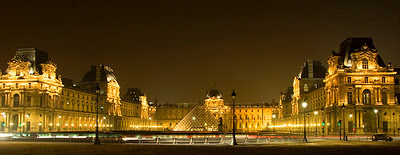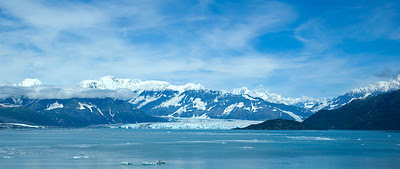When you go to an exhibition of photographs, what type of photo always seems to be one remembered? It’s the sweeping panorama.

Panoramas of a scene seem to take the image to new heights. They make landscapes more dramatic and vivid. Mountains become more majestic. Horizons become more exciting. Even a panoramic style view of great architecture becomes more admirable. The above panorama, made from five photographs stitched together, taken in Monument Valley, far better represents the feeling one gets traveling among the Valley’s natural wonders than squarish photographs.
We’re used to seeing photographs in the typical 3:2 aspect ratio of width to height which started with the invention of the 35mm film format, and is carried through on today’s digital cameras, both the
DSLR’s and
Point & Shoot varieties. The most common print sizes of 5x7, 8x10, and 11x14, generally adhere closely to the squarish 3:2 ratio.
I think that part of the reason panoramas so appeal to the eye is their departure from the 3:2 format, and the easy way they draw your eye across their “canvas.” The appeal of
Cinemascope, the first widely accepted “wide” movie format, is much the same. Cinemascope allowed movies to go to a 2.66:1 aspect ratio, twice as wide as the conventional format of 1.33:1. With Cinemascope, the breathtaking beauty of the background of some of the classic movies of the 50’s and 60’s and beyond was greatly enhanced.
Imagine what “Ben Hur” or “Lawrence of Arabia” would look like, reduced to a square screen. Without their wide screen aspect ratio, in my opinion, neither of these films would have won an Oscar for “Best
Cinematography.”

You don’t have to limit your panoramas to landscapes, though they are the most familiar use of the wide aspect ratio photograph. Buildings, city-scapes, groups of people, and parades are all great subjects for panoramas. Isn’t this photograph of the Louvre in Paris at night made more dramatic by its wide aspect ratio?
There are two basic methods for producing a panorama photograph. The easiest way is to take a wide angle view of your subject and crop it to produce an image with a wide aspect ratio. This is how I produced the photograph of the Louvre above.
Some Point and Shoot digital cameras have a “Panorama Mode.” If your camera has one, use it. It will enable you to get some spectacular results with some practice.
The other method for creating a panorama photograph is to take several photos of your subject, moving your camera across the subject, being careful to overlap each shot, then stitch them together with an image editor on your computer. Both Photoshop and Photoshop Elements contain tools to stitch photos together, or you can use specialized software to accomplish this task. I use PanaVue Image Assembler for my multi-image panoramas. It allows me excellent control in creating the combination image.
While you can hand hold your camera to take multiple photographs stitched together into a panorama, I strong suggest you use a tripod. Using a tripod allows you to easily keep each photo in the panorama in the same horizontal plane. I use a special panorama head on my tripod for these shots, which makes leveling the tripod easier, and helps you rotate your camera a specific number of degrees between each photo.
While you’re looking horizontally to produce panoramas, there may be some opportunities for vertical panoramas too. Don’t loose sight of these vertical possibilities.

Don’t forget the “
Rule of Thirds” when taking panoramas.
Take my word for it, or try it yourself. Placing the bay’s horizon in the lower third of this photo of the Hubbard Glacier in Alaska, close to the intersection of the lower third with the middle third, made this panorama much more pleasing to the eye, than if I placed the bay’s horizon across the middle of the photograph.
In
Panorama Photography Part II, I will discuss techniques for taking your photographs for multiple image stitched panoramas.



